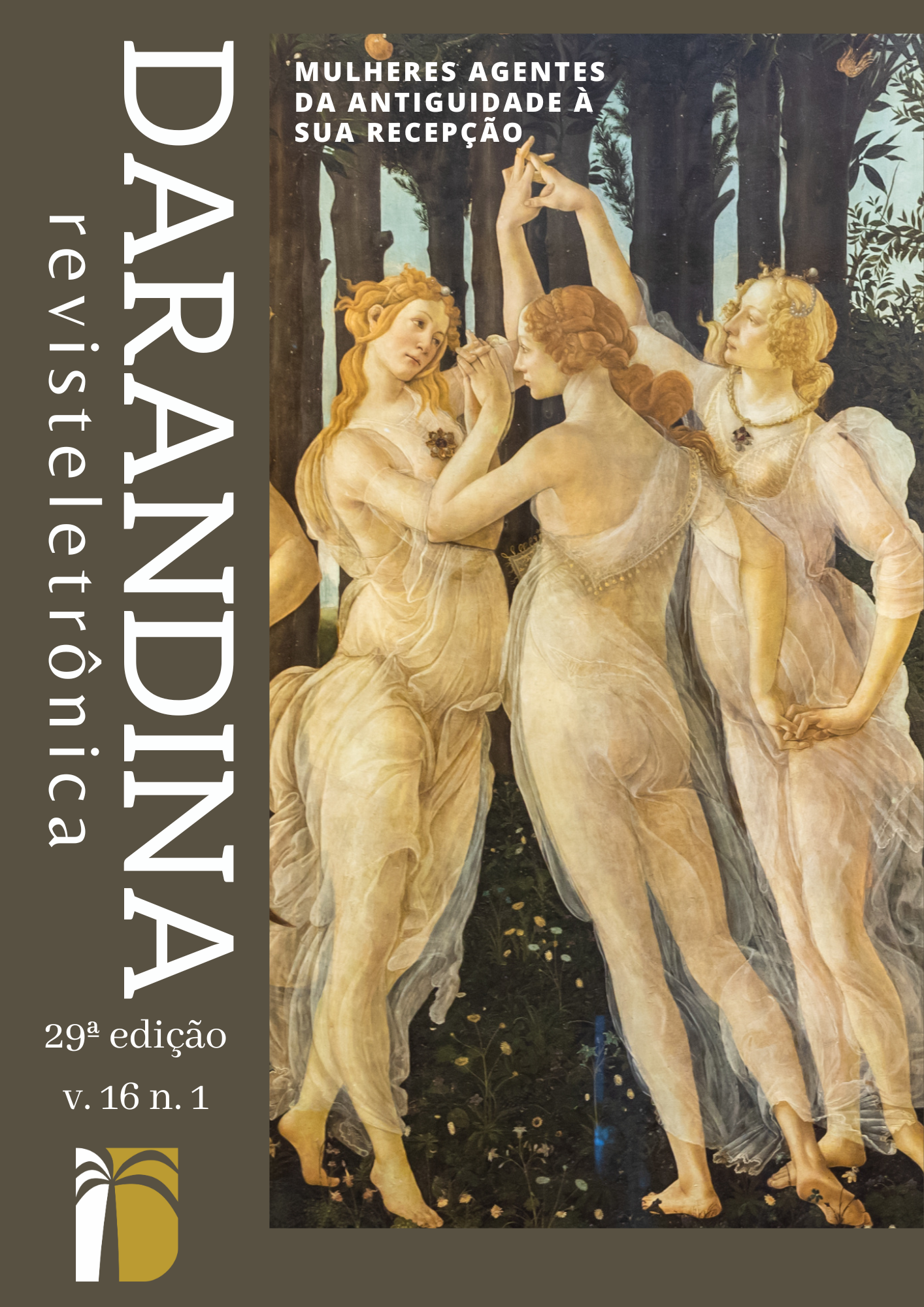O BELO, ALÉM DA BELEZA, E A RECEPÇÃO DO FEMININO GRECO-ROMANO NO CANCIONEIRO PARAIBANO DE CHICO CÉSAR E ZÉ RAMALHO
DOI:
https://doi.org/10.34019/1983-8379.2023.v16.41054Palavras-chave:
Mitologia clássica, feminino, cancioneiro popular, Zé Ramalho, Chico CésarResumo
No que se refere ao estudo dos mitos, um aspecto que julgamos ser fundamental é o seu alcance universal, como aquele em que se vê o seu direcionamento às mais diversas formas de conhecimentos e culturas. Especialmente, nosso interesse é ainda maior quando essa presença se faz notória na cultura brasileira. Como sabemos, as narrativas míticas são reinterpretadas por diversos autores e artistas, conduzindo criações artísticas que expressam ideias e emoções de maneira poética e simbólica. Além disso, a mitologia oferece uma rica fonte de histórias adaptáveis, permitindo reflexões contemporâneas sobre valores históricos e representativos. E, diante dessa percepção interpretativa e intertextual, artistas como Zé Ramalho, Chico César e Chico Buarque, entre outros, fazem uso dessas histórias mitológicas em suas composições. Com isso, este artigo visa explorar a presença da mitologia nas canções populares, particularmente, nas que expressam uma ênfase nas figuras femininas míticas, como fundamentação de análise da recepção do feminino em sua abordagem, não só na Antiguidade, como nos tempos atuais, de modo que possamos contribuir para uma compreensão do feminino no mundo clássico sob uma perspectiva atemporal. Para tanto, dialogaremos com autores como Martha Robles (2019), Luciana Ferreira Mendonça (s/d), Marta Mega de Andrade (2003), Airan Borges dos Santos (2020), Verônica de Fátima Gomes Moura (2011), Pierre Bourdieu (1989) e Marcus Reis Pinheiro (2010). Com esse propósito, realizaremos a exposição de três tópicos: 1. Além da beleza, a essência do Belo e sua dimensão: contextualização sobre o feminino e o belo na Antiguidade; 2. Entre objetificações e sentidos genuínos: a recepção da mulher da Antiguidade greco-romana no cancioneiro popular de Zé Ramalho e Chico César; 3. Análise da representação feminina greco-romana em “Mulher nova, bonita e carinhosa”, de Zé Ramalho. Ao longo dos tópicos propostos, abordaremos como cada um se correlaciona entre si, abarcando os métodos de estudo e análise para alcançar tal objetivo de pesquisa
Downloads
Referências
AGAMBEN, Giorgio. O que é o contemporâneo? E outros ensaios. Tradução de Vinícius Nicastro. Chapecó: Argos, 2009.
ANDRADE, Marta Mega. A “Cidade das Mulheres”: a questão feminina e a pólis revisitada. Disponível em: https://www.academia.edu/827647/A_Cidade_das_mulheres_a_quest%C3%A3o_feminina_ea_P%C3%B3lis_revisitada. Laboratório de História Antiga/UFRJ, 2003.
BRANDÃO, Junito de Souza. Mitologia grega. Vol 1. 8. ed. Petrópolis: Vozes, 1993.
BOURDIEU, Pierre. O poder simbólico. Rio de Janeiro: Bertrand Brasil, 1989.
CÉSAR, Chico. Esta. In: Cuzcuz clã, 1996. Disponível em: https://www.letras.mus.br/chico-cesar/45195/. Acesso em: 25 mar. 2023.
BUARQUE, C.; BOAL, A. Mulheres de Atenas. In: Meus caros amigos, 1976. Disponível em: http://letras.terra.com.br. Acesso em: 04 abr. 2023.
MENDONÇA, Luciana Ferreira. Literatura e oralidade: da canção poética à canção popular. Campinas: UNICAMP, s/d.
MOURA, Verônica Fátima Gomes. A Canção no Contexto das Relações da Poesia com a Música. Anais. XII Congresso Internacional da ABRALIC/UFPR, 2011. UFPR. Disponível em: https://abralic.org.br/eventos/cong2011/AnaisOnline/resumos/TC0536-1.pdf. Acesso em: 26 abr. 2023.
PINHEIRO, Marcos Reis. Religião e Estética na Grécia antiga. Revista Exagium, v. 8, n. 8, 2010. Disponível em:
https://periodicos.ufop.br/exagium/article/view/5906. Acesso em: 26 abr. 2023.
CÉSAR, Chico. Esta. 1996. Disponível em: https://www.letras.mus.br/chico-cesar/45195/. Acesso em: 11 ago. 2023.
RAMALHO, Zé; CORTÊS, Lula. Pedra templo animal. 1975. Disponível em: https://www.letras.mus.br/ze-ramalho/pedra-templo-animal/. Acesso em: 03 abr. 2023.
RAMALHO, Zé; BATISTA, Otacílio. Mulher nova, bonita e carinhosa. In: Mulher nova, bonita e carinhosa faz o homem gemer sem sentir dor, 1982. Disponível em: https://immub.org/album/mulher-nova-bonita-e-carinhosa-faz-o-homem-gemer-sem-sentir-dor. Acesso em: 03 abr. 2023.
ROBLES, Martha. Mulheres, Mitos e Deusas: o feminino através dos tempos. São Paulo: Goya, 2019.
SANTOS, Airan Borges. Quando os deuses visitaram os sertões: a Antiguidade Clássica nos cordéis de João Martins de Ataíde. Rio de Janeiro: Phoenix, 2020.
Downloads
Publicado
Como Citar
Edição
Seção
Licença
Copyright (c) 2023 Edjane Henrique de Oliveira Silva, Michelle Bianca

Este trabalho está licenciado sob uma licença Creative Commons Attribution 4.0 International License.

Este trabalho está licenciado sob uma licença Creative Commons Attribution 4.0 International License.
Direitos Autorais
Autores que publicam nesta revista concordam com os seguintes termos:
1. Autoras e autores mantêm os direitos autorais e concedem à revista o direito de primeira publicação, sendo esta licenciada sob a Creative Commons Attribution License 4.0 Internacional.
2. Autoras e autores têm permissão e são estimuladas(os) a publicar e compartilhar o trabalho com reconhecimento da publicação inicial nesta revista.
3. Autoras e autores dos trabalhos aprovados autorizam a revista a ceder o conteúdo de seus trabalhos, após sua publicação, para reprodução em indexadores de conteúdo, bibliotecas virtuais e similares.
Para mais informações sobre a Creative Commons Attribution 4.0 International License, acessar: https://creativecommons.org/licenses/by/4.0/



















